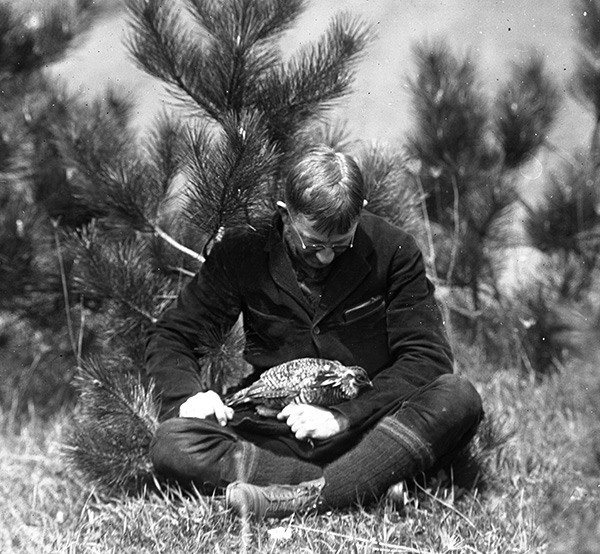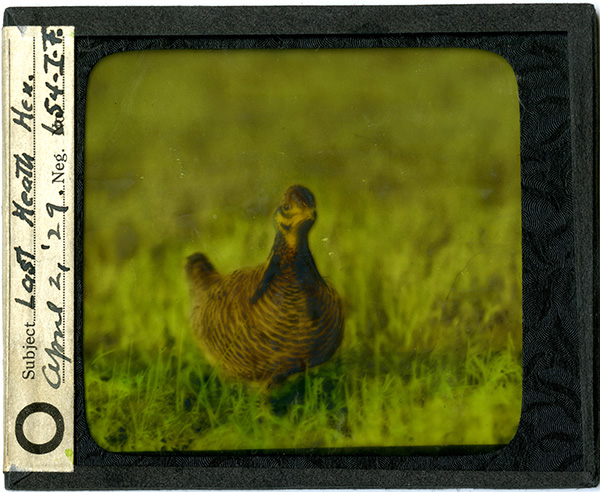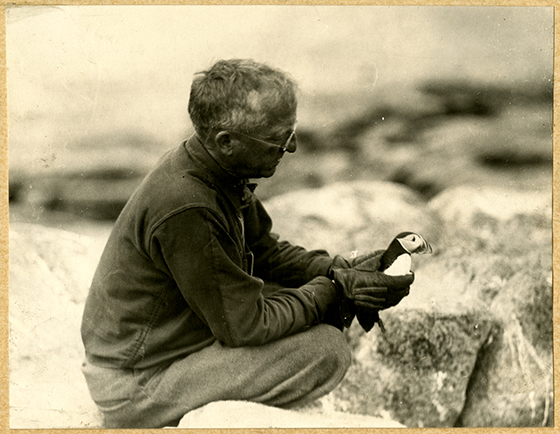The Last of the Heath Hens: Special Collections Receives Grant to Preserve 1930s
By Doug Cook
It’s full circle moment for Edward Minot, the interim director of the Bowdoin Scientific Station on Kent Island.
Films documenting ornithological research done in the 1930s by his grandfather, Bowdoin professor of biology Alfred Otto Gross, Kent Island’s first director, will be digitized and preserved, thanks to a grant Bowdoin’s George J. Mitchell Department of Special Collections & Archives has received from the National Film Preservation Foundation.
Minot discovered the 35 mm films, as well as several reels of 16 mm films, in his mother’s attic.
A biologist and ornithologist like his grandfather, Minot immediately recognized the research potential and fragility of the films.
“After a lifetime of hearing about my grandfather’s work with Heath Hens and his trips with MacMillan, it will be thrilling to see movies of the events for which I’ve had mostly an oral history and a few photographs,” wrote Minot in an email from Kent Island.

In 2015, Minot donated them on behalf of the family to Special Collections & Archives with the wish that digital copies of the films be made available online via open access.
The films, The Heath Hen (circa 1932, one reel) filmed on Martha’s Vineyard, Massachusetts, and The Birds of Grenfelland (circa 1931, four reels) filmed in the Labrador region of Canada, show bird populations in their native habitats and include rare footage of the last surviving Heath Hen, whose passing in 1932 marked the species’ extinction.
The footage also includes brief scenes of Inuit coastal communities, Sir Wilfred Grenfell aboard his missionary ship, the Strathcona II, and naturalist and children’s author Thornton Burgess, who accompanied Gross on several research expeditions.
Gross documented a period of significant change in both bird populations and habitats, and as such, his films have historical and cultural significance.

Gross had a long career devoted to teaching and the study of birds. He was a professor of biology from 1913 until his retirement in 1953, an internationally respected ornithologist, and a was a rigorous field researcher, studying bird populations in the eastern regions of the United States, Canada, and Panama, among other locales.
In addition to his tenure as director at Kent Island, Gross was also an ornithologist on the Arctic explorer Donald B. MacMillan‘s expedition to Labrador in 1934, and, beginning in 1923, directed the State of Massachusetts’ Heath Hen Investigation — a long-term project to record and protect the endangered Heath Hen species, work that Gross later described as “the most interesting and rewarding project I had ever undertaken.”
“We really appreciate the National Film Preservation Grant as it will allow us both to preserve these important films for the long-term, and to make them publically accessible online, which was something the donor [Minot] really wanted to see happen — to share this unique footage with the wider public,” said Caroline Moseley, archivist for the George J. Mitchell Dept. of Special Collections & Archives.
“Researchers will be fascinated to see rare film of the now extinct Heath Hen, as well as the abundant birdlife, from over 80 years ago, in fragile coastal environments of the Labrador region in Canada.”
The grant will allow Special Collections to outsource the film preservation work to Colorlab in Maryland where the film will be inspected, cleaned, and repaired and then scanned at high resolution and new 35mm, polyester, black-and-white, duplicate negatives and prints created from the data files. Once the preservation project is completed these important films will be preserved for the long-term and the digitized copies will be freely accessible online.
The NFPF preservation grants target newsreels, silent-era films, culturally important home movies, avant-garde films, and endangered independent productions that fall under the radar of commercial preservation programs. The awards provide support to create a film preservation master and two access copies of each work.
Films saved through the NFPF programs are made available to the public for on-site research and are seen widely through screenings, exhibits, DVDs, television broadcasts, and the Internet.
The National Film Preservation Foundation is the nonprofit organization created by the U.S. Congress to help save America’s film heritage. The NFPF is the charitable affiliate of the National Film Preservation Board of the Library of Congress.



